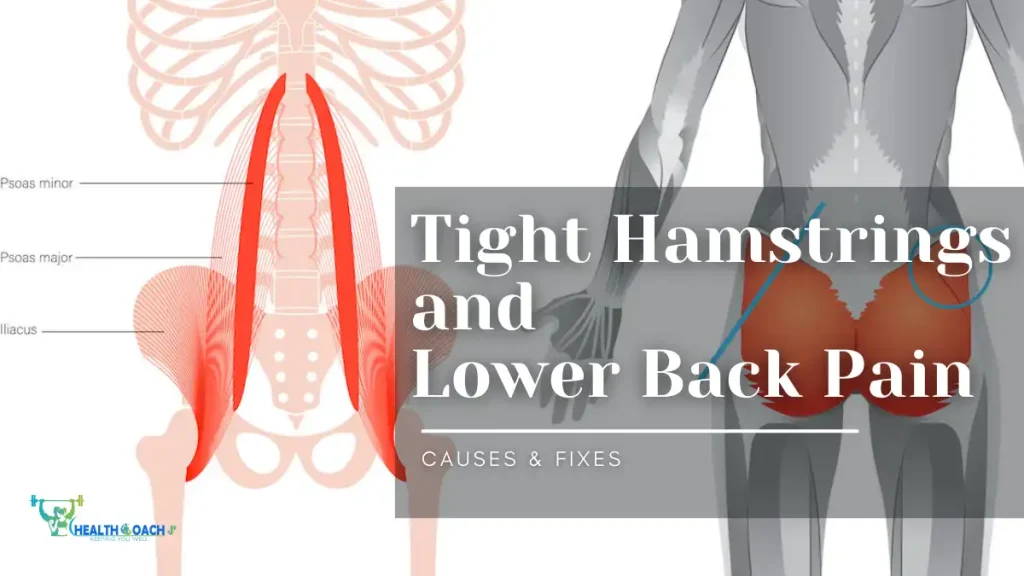Lower back pain is one of the most common physical complaints worldwide, affecting millions every year. While causes vary—from disc injuries to muscle strain—tight hamstrings are an often-overlooked contributor. Understanding this link is critical for finding lasting relief.

We’ll explore the anatomy of your hamstrings, exactly how tight hamstrings can cause or worsen lower back pain, and five evidence-backed stretches to improve flexibility. We’ll also add expert resources, medical references, and a relevant YouTube video for more guidance.
Where Are the Hamstrings Located?
Your hamstrings are three large muscles at the back of your thigh:
- Biceps femoris (outer hamstring)
- Semitendinosus (middle)
- Semimembranosus (inner)
They start at the pelvis (ischial tuberosity) and cross the knee joint, enabling you to bend your knee and extend your hip.
Primary Functions of the Hamstring Muscles
- Knee flexion (bending the knee)
- Hip extension (moving your thigh backward)
- Supporting posture and balance during walking, standing, or bending
When flexible and strong, hamstrings assist spinal alignment and pelvic stability. When tight, they can pull on the pelvis and disrupt the natural curve of your lower back, leading to strain.
What Causes Tight Hamstrings?
Some common causes include:
- Sedentary Lifestyle – Sitting for long hours shortens the hamstring muscles.
- Overtraining Without Stretching – Exercise without flexibility work leads to muscle tightness.
- Injury/Strains – Scar tissue can reduce hamstring mobility.
- Poor Posture – Slouching or pelvic tilt can shorten hamstrings over time.
- Genetic Flexibility Limits – Some individuals naturally have tighter muscles.
Pro tip: An inactive job alone can shorten hamstrings enough to affect lower back mechanics.
Can Tight Hamstrings Cause Back Pain?
Yes. Tight hamstrings pull the pelvis downward and backward, flattening your natural lumbar curve. This places extra stress on the lower spinal discs and ligaments, resulting in discomfort or pain.

Example: Imagine a rope tied from your pelvis to the back of your knees (your hamstrings). If that rope tightens, it tilts your pelvis and alters spinal alignment, creating strain.
The Link Between Tight Hamstrings, Glutes, and Lower Back Pain
- Tight hamstrings often coexist with tight glutes.
- The gluteus maximus—your buttock muscle—works with hamstrings for hip extension.
- Sitting too long tightens both muscle groups, reducing hip mobility and forcing the lower back to compensate.
Key takeaway: Hamstring tightness rarely occurs alone—it’s part of a chain involving your lower back, pelvis, and hip muscles.
5 Best Hamstring Stretches for Lower Back Pain Relief
Before attempting stretches, consult a physiotherapist if you have severe pain or injury.
1. Chair Hamstring Stretch
- Sit on a chair, place one leg on another chair in front of you.
- Keep your back straight, reach toward your toes.
- Hold for 20–30 seconds.
2. Wall Hamstring Stretch
- Lie on your back with your buttocks against a wall.
- Place one or both legs up the wall.
- Straighten your leg as much as possible without pain.
- Hold for 30 seconds.
3. Standing Forward Bend
- Stand tall, feet hip-width apart.
- Bend forward slowly, reach toward the floor.
- Avoid locking knees; stop if pain increases.
4. Towel Hamstring Stretch
- Lie on your back, loop a towel around one foot.
- Gently pull your leg toward you while keeping it straight.
- Switch sides.
5. Lying Hamstring Stretch with Strap
- Lie on your back, knees bent, feet on floor.
- Extend one leg upward with a strap looped around your foot.
- Hold for 20–30 seconds per leg.
How to Stretch Tight Hamstrings for Lower Back Pain Relief
A step-by-step guide on safe hamstring stretching to ease back pain.
Lifestyle Tips to Prevent Tight Hamstrings and Back Pain
- Move Every Hour – Stand or walk briefly to prevent muscle shortening.
- Warm-Up Before Exercise – Dynamic stretches improve flexibility.
- Strengthen Core Muscles – A strong core reduces strain on your back.
- Maintain Good Posture – Keep hips aligned and avoid slouching.

When to See a Doctor
Seek medical advice if:
- Pain persists beyond 2–3 weeks.
- Pain radiates down your leg (possible sciatica).
- You experience numbness or weakness.
Key medical credibility additions
- Evidence shows hamstring stretching can reduce pain intensity and improve function in low back pain, with notable benefits for cases with radiating pain.
- Tight hamstrings can disrupt pelvic motion and lumbar mechanics; combining flexibility work with core strengthening and motor control exercises improves outcomes.
- Major health systems recommend gentle hamstring stretches as part of low back pain care pathways.
Conclusion
“Tight hamstrings and lower back pain” are interconnected through the pelvis and spine. Addressing hamstring flexibility can significantly reduce back discomfort, improve mobility, and prevent injury. Consistency in stretching, correcting posture, and strengthening supportive muscles is the real key.
FAQs about Tight Hamstrings and Lower Back Pain
Tight hamstrings tilt the pelvis backward, altering spinal alignment and increasing tension in the lower back.
Stretching helps, but core strengthening, posture correction, and regular mobility work are also key.
Aim for daily hamstring stretches, holding each for 20–30 seconds, 3–4 times per leg.
Trusted medical authorities for more info:
